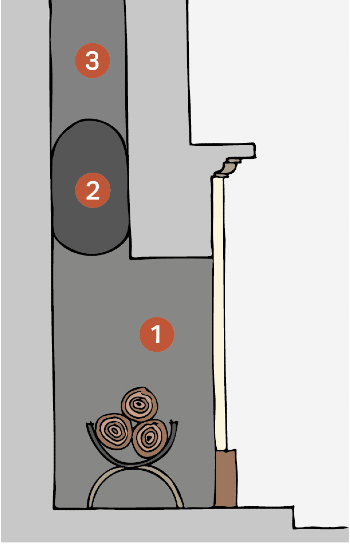
Section drawing of a chimney showing a chimney balloon
1. The open fireplace can remain as a feature in the room and without needing to be permanently closed it can easily be used when required.
2. A chimney balloon is a simple DIY installation fitted within easy reach at the foot of the flue. The air-bag adopts the shape of the flue as it is inflated and provides an air cell which acts as a thermal buffer to insulate against heat loss, as well as a physical barrier to reduce draughts.
3. The existing flue remains unaltered and capable of functioning normally when the chimney balloon is deflated.
Most older buildings and many modern ones contain a chimney or flue, serving a fireplace. All of these have an open throat at the hearth, connected to the outside by a narrow void, or flue, that normally terminates at roof level.
In an active fireplace the flue will be warmed by the fire and the thermal mass of the chimney will help dissipate heat around the home. A used flue is unlikely to suffer from cold down-draughts unless it is not working properly, but a fully functioning flue loses a significant portion of the heat produced by a fire directly to the outside. In an un-used fireplace however the picture is different. The flue becomes a route by which cold air can enter the building and energy used for heating the home by central heating, for example, is wasted.
A chimney balloon is a simple and effective means to prevent draughts and reduce heat loss from un-used flues. It can also significantly reduce noise infiltration, which may be of benefit for properties in town centres or close to roads, rail, and flight-paths.
The balloon consists of a simple plastic air-bag which is placed inside the chimney flue and inflated by a foot pump or tube until it forms a snug fit with the sides of the chimney flue forming an effective seal. Balloons are available in a range of standard sizes to suit the most commonly found flues, but can also be made to measure for even the largest and most unusually shaped flues.
Balloons are simply fitted and fully reversible; they can easily be removed for cleaning or during the fairer summer months, when natural stack-effect ventilation through a chimney would reduce energy consumption from mechanical extract fans and air conditioning systems.
Open chimney flues do aid natural ventilation and the removal of moisture and damp, so it is not always advantageous to block a flue permanently or completely.
As much as 80% of the heat from a room can pass through a chimney flue. The insertion of a chimney balloon will greatly reduce this figure.
By being both adjustable and reversible a chimney balloon can be effective during the winter months, and allow the flue to provide ventilation and cooling during the summer months.
Together with a valve, pump, and re-usable air-bag, a chimney balloon installation can cost less than £30.
The effect on reducing energy consumption means this modest sum can easily be recovered in the first year.
Listed Building Consent is not normally required, unless the appearance of the room would be significantly affected.
Temporarily sealing of unused flues is also a simple process that does not require consent – chimney balloons are simple to fit and are removable. Typically, they also permit some air flow through being ill-fitting, which is important for ventilation. The total and comprehensive sealing of flues is not recommended.
We support careful draughtproofing of chimneys where there is no detrimental impact on the special architectural or historic interest of the building or historic fabric.
In the light of the Climate Emergency, we will generally permit and encourage alterations on listed buildings, with special regard to the the following:
- Preserving the building, its setting or any features of special architectural or historic interest which it possesses
- Preserving or enhancing the character of a conservation area
- Respecting the significance of any non-designated heritage asset
Draughtproofing Older Buildings also from Historic England
